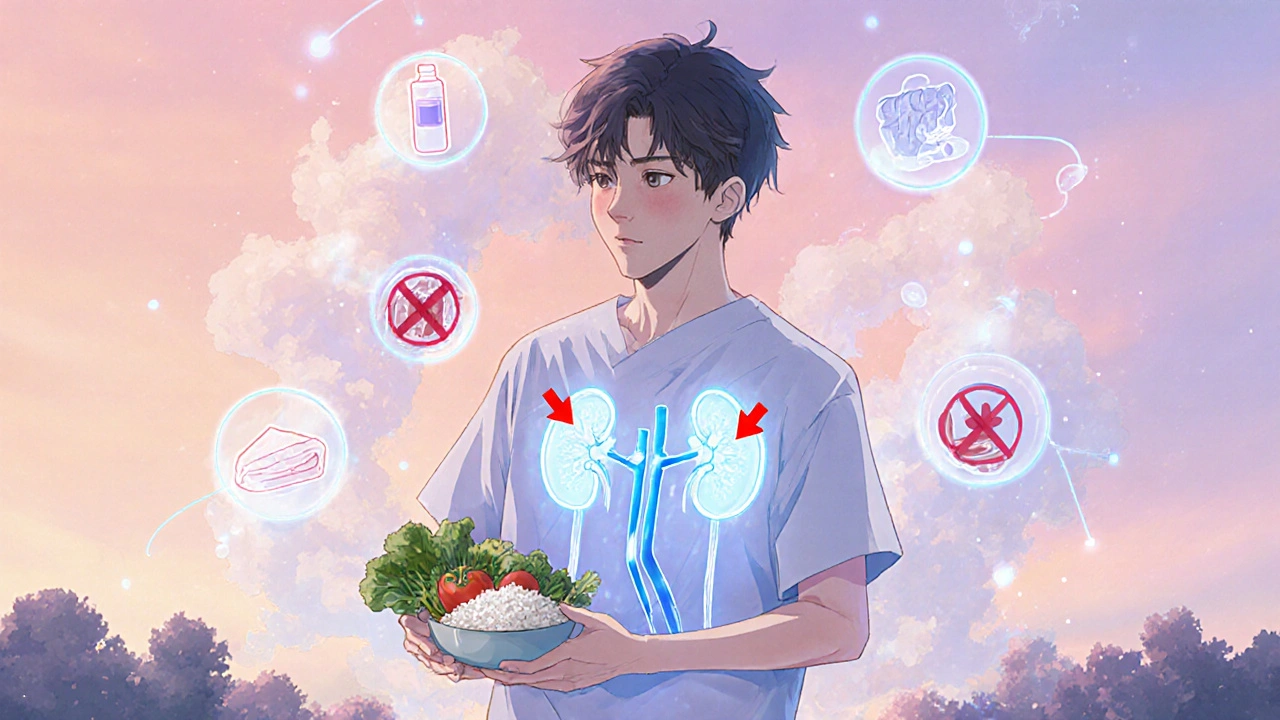Why a Renal Diet Matters for Kidney Disease
If your kidneys aren’t working well, what you eat directly affects how sick you feel and how fast your condition gets worse. A renal diet isn’t about losing weight or eating clean-it’s about protecting what’s left of your kidney function by controlling three dangerous minerals: sodium, potassium, and phosphorus. These aren’t just ordinary nutrients. When kidneys fail, they can’t flush out the excess, and that buildup can cause heart problems, bone damage, or even sudden cardiac arrest.
The goal isn’t to eliminate these minerals completely. It’s to keep them in a safe range so your body doesn’t go into crisis. For someone with stage 3 or 4 chronic kidney disease (CKD), this diet can delay the need for dialysis by up to a year. That’s not a small thing. It means more time at home, fewer hospital visits, and better quality of life.
Sodium: The Silent Fluid Bully
Sodium doesn’t just make food taste good-it makes your body hold onto water. For healthy people, that’s fine. For someone with weak kidneys, it’s a disaster. Extra fluid builds up in the lungs, legs, and around the heart, raising blood pressure and making breathing difficult.
The standard limit? Between 2,000 and 2,300 milligrams per day. That’s less than one teaspoon of table salt. But here’s the catch: 75% of sodium in the average diet comes from packaged and processed foods. A single serving of canned soup can have more than half your daily limit. Deli meats, frozen meals, bread, and even breakfast cereals are loaded with hidden salt.
How to cut back? Start by reading labels. Look for “low sodium,” “no salt added,” or “unsalted.” Avoid anything with more than 140 mg of sodium per serving. Use herbs like rosemary, thyme, or garlic powder instead of salt. Mrs. Dash and similar blends are safe and flavorful. Studies show that cutting sodium by just 1,000 mg a day can lower systolic blood pressure by 5 to 6 points in CKD patients-enough to reduce strain on your heart and kidneys.
Potassium: The Heart’s Balancing Act
Potassium helps your muscles and nerves work right. But when your kidneys can’t remove it, levels rise dangerously. Above 5.5 mEq/L, potassium can trigger irregular heartbeats-or stop your heart entirely. That’s why it’s one of the most closely watched numbers in kidney care.
The recommended daily limit for most non-dialysis CKD patients is 2,000 to 3,000 mg. But this isn’t one-size-fits-all. Your doctor will adjust it based on your blood test results. Some people can handle more; others need to be stricter.
High-potassium foods to limit: bananas (422 mg each), oranges (237 mg each), potatoes (610 mg per medium), tomatoes (292 mg per cup), spinach (839 mg per cup cooked), and avocados (708 mg per half). These are often called “healthy foods,” but they’re risky for kidneys.
Lower-potassium swaps: apples (150 mg), berries (65 mg per half cup blueberries), cabbage (12 mg per half cup cooked), green beans (180 mg per cup), and white rice. You can also reduce potassium in vegetables by leaching: peel, slice thin, soak in warm water for 2-4 hours, then boil in plenty of water and discard the water. This cuts potassium by about half.
Important note: Potassium from animal sources (meat, dairy) is absorbed more easily than from plants. So even if you eat plant-based foods, portion control still matters.
Phosphorus: The Hidden Bone Thief
Phosphorus is everywhere-in food, in additives, and even in your bones. Healthy kidneys balance it. Damaged kidneys don’t. When phosphorus builds up, it pulls calcium out of your bones, making them weak and brittle. It also causes dangerous calcium deposits in your blood vessels, heart, and skin.
The target for non-dialysis CKD patients is 800 to 1,000 mg per day. But here’s the twist: not all phosphorus is the same. Natural phosphorus in foods like meat, dairy, and beans is only 40-70% absorbed. But inorganic phosphorus-added to processed foods-is nearly 90-100% absorbed. That’s why a soda with phosphoric acid is far worse than a glass of milk.
Steer clear of: colas (450 mg per 12 oz), processed cheeses (250 mg per slice), deli meats with phosphate preservatives, instant mashed potatoes, and packaged baked goods. Check ingredient lists for words like “phos,” “phosphate,” or “pyrophosphate.” If you see them, skip it.
Good choices: fresh meats (in small portions), egg whites (12 mg per white), white bread (60 mg per slice), rice milk (10 mg per cup), and apples. Dairy is tricky-half a cup of milk has 125 mg, so limit it to one serving a day. If you need more calcium, ask your doctor about calcium-based binders taken with meals.

Putting It All Together: A Day on a Renal Diet
Let’s say you’re managing stage 4 CKD. Here’s what a realistic day might look like:
- Breakfast: White toast (2 slices, 120 mg phosphorus), 1 egg white (12 mg phosphorus), ½ cup blueberries (65 mg potassium), unsweetened tea.
- Lunch: Grilled chicken breast (3 oz, low sodium), ½ cup cooked cabbage (12 mg potassium), ½ cup white rice (15 mg phosphorus), apple slices (150 mg potassium).
- Dinner: Baked cod (3 oz, 200 mg potassium, 200 mg phosphorus), ½ cup boiled green beans (180 mg potassium), 1 small dinner roll (50 mg phosphorus).
- Snack: 1 small pear (190 mg potassium), unsalted popcorn (15 mg sodium).
Notice what’s missing? No salt shaker. No bananas. No cheese. No soda. No instant noodles. That’s intentional. This isn’t deprivation-it’s smart adaptation.
Many people struggle at first. Food tastes bland. Meals feel repetitive. That’s normal. It takes 3 to 6 months to adjust. Use herbs, lemon juice, vinegar, or black pepper to add flavor without sodium. Over time, your taste buds reset-and you won’t miss the salt as much.
What About Protein? The Big Misconception
For years, people with kidney disease were told to eat as little protein as possible. That advice has changed. Too little protein leads to muscle loss, weakness, and higher risk of infection-especially in older adults.
Current guidelines recommend 0.55 to 0.8 grams of protein per kilogram of body weight per day. That’s about 40-60 grams for most people. Focus on high-quality sources: eggs, fish, lean poultry, and plant proteins like tofu in moderation.
Salmon, cod, and tuna are good choices-low in sodium, moderate in potassium and phosphorus. Stick to 2-3 ounce portions, 2-3 times a week. Avoid processed meats like bacon, sausage, or deli slices-they’re packed with sodium and phosphorus additives.
Research from 2022 shows that people on too-low protein diets had a 34% higher risk of malnutrition. The goal isn’t to starve your body-it’s to feed it wisely.
Fluids, Supplements, and Other Considerations
Many people on a renal diet also need to limit fluids. If you’re producing less than 1 liter of urine a day, you may be asked to cap intake at 32 ounces (1 liter) daily. This includes water, coffee, tea, soup, ice cream, and even gelatin. Every sip counts.
Supplements are tricky. Over-the-counter multivitamins often contain potassium or phosphorus. Always check with your dietitian before taking anything. Some CKD patients need special renal vitamins that exclude these minerals.
Also, avoid salt substitutes. Many contain potassium chloride, which can spike your levels dangerously. They’re not safer-they’re riskier.

Tools and Support That Actually Help
You don’t have to figure this out alone. The National Kidney Foundation, DaVita, and the Academy of Nutrition and Dietetics offer free meal plans, food lists, and apps. The Kidney Kitchen app, downloaded over 250,000 times, lets you scan barcodes and see sodium, potassium, and phosphorus content in real time.
Medicare now covers 3-6 sessions per year with a registered dietitian nutritionist (RDN) for stage 4 CKD patients. These sessions aren’t just helpful-they save money. Delaying dialysis by even a few months can save $12,000 per person annually.
And if you have diabetes, you’re not alone. About 44% of new kidney disease cases come from diabetes. But the heart-healthy diet for diabetics often clashes with the renal diet. A dietitian can help you find the overlap-like choosing berries over oranges, or cauliflower rice over brown rice.
What’s New in Renal Nutrition
The field is evolving. In 2023, the FDA approved the first medical food for CKD, called Keto-1, which provides essential amino acids without adding phosphorus or potassium. Researchers are also testing prebiotic fibers like inulin, which may reduce phosphorus absorption by 15-20%.
A new NIH study called PRIORITY is exploring whether genetic testing can predict how your body handles potassium and phosphorus. This could lead to personalized diets tailored to your DNA, not just your lab numbers.
But here’s the most important shift: doctors are moving away from extreme restriction. A 2023 review in JAMA Internal Medicine found that focusing on food quality-choosing whole, unprocessed foods over ultra-processed ones-does more for long-term health than strict limits. It’s not about perfection. It’s about progress.
Frequently Asked Questions
Can I still eat fruits and vegetables on a renal diet?
Yes, but you need to choose carefully. Low-potassium options like apples, berries, cabbage, green beans, and cauliflower are safe in controlled portions. Avoid high-potassium choices like bananas, oranges, potatoes, and spinach. Leaching vegetables by soaking and boiling them can cut potassium by up to half.
Is dairy allowed on a renal diet?
Dairy is high in both phosphorus and potassium, so it’s limited. Half a cup of milk has 125 mg of phosphorus and 180 mg of potassium. If you need calcium, consider calcium-based phosphate binders taken with meals. Plant-based milks like rice milk (unsweetened) are lower in both minerals and can be better alternatives.
Why are phosphorus additives worse than natural phosphorus?
Natural phosphorus in foods like meat or beans is only 40-70% absorbed by your body. But phosphorus additives-used in processed foods to extend shelf life or enhance flavor-are almost 90-100% absorbed. That means a soda with phosphoric acid delivers far more phosphorus than a piece of chicken with the same label amount.
Can I use salt substitutes if I’m on a renal diet?
No. Most salt substitutes contain potassium chloride, which can raise your potassium levels to dangerous levels. Even if you’re avoiding table salt, these substitutes can put you at risk for heart rhythm problems. Use herbs, lemon juice, or spice blends like Mrs. Dash instead.
How long does it take to get used to a renal diet?
Most people need 3 to 6 months to adjust. At first, food may taste bland, and meal planning feels overwhelming. But your taste buds adapt. Over time, you’ll start to enjoy the natural flavors of food again. Support from a renal dietitian and tools like the Kidney Kitchen app make the transition much easier.
